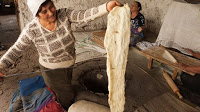Last March, Doug and I were contacted by Rebecca Wall, PhD,
Program Officer of Research and Communications with the Smithsonian
Institution. Rebecca was, as she put it, “part of a new Smithsonian project to
support the sustainability of Armenian cultural heritage through
community-based tourism in the regions outside of Yerevan. The ‘My Armenia’ program, in partnership with
United States Agency for International Development (USAID), seeks to share
stories of Armenian cultural heritage with international audiences so as to
increase awareness of the great complexity and diversity of Armenian culture.”
The Smithsonian’s comprehensive article, ‘Tastes of Memory: How to Bake an Authentic Armenian Lavash’, including Doug’s contribution, appeared on
their website last April. Please click here to read it.
A few days ago, I received an email from Lucine Kasbarian,
who brought to my attention an article (and video) from the Smithsonian Center
for Folklife and Cultural Heritage, called ‘A Taste of the Wild side: Out of
Yerevan and into Armenia’s Local Dishes’. The focus being on aveluk (wild
sorrel) which grows naturally in the Armenian countryside.
    |
| Aveluk soup from Our Village restaurant, Yerevan |
This article quickly brought to mind our incredible journey
to Armenia in 2015 when we tasted so
many tantalizing and unique dishes, including aveluk soup. I ordered it at ‘Our
Village’ restaurant in Yerevan; the article featured Dolmama restaurant’s aveluk
soup. We were surprised to learn that few restaurants feature this signature
Armenian dish.
Since aveluk, which has a somewhat acidic – sour taste is unavailable in the US, and wild sorrel is hard to come by, suitable
substitutes may include kale, collard greens, Swiss chard, or spinach.
Please click here to read the ‘Taste of the Wild Side’
article and to view the video. It’s in Armenian, but there are English
subtitles!
As a bonus, I am re-posting Sonia Tashjian’s recipe for
Aveluk Soup.   |
| Sonia Tashjian’s Aveluk Soup |
Aveluk Soup, courtesy of Sonia Tashjian
6 ounces (about 4 cups) dried aveluk (See preparation of
aveluk below) 6 to 8 cups of water (See step #3) 1 potato, peeled and chopped dried plums, pitted
and chopped (amount depends on how sour the aveluk is) Aleppo red pepper
& black pepper, to taste 2 Tbsp. flour, or some cut pieces of lavash, optional a little bunch of fresh coriander, chopped 1 or 2 cloves garlic, minced
Place the dried aveluk in a large bowl of hot water. Let it
sit for several minutes. Drain the water. Do this procedure two more times.
1. Add 6 cups of water to a large pot; bring to a boil and
add 2 tsp salt. To the pot of boiling water, add the bulgur, onion &
potato. Reduce heat and continue to cook, stirring occasionally. (NOTE: Lentils
may be substituted for the bulgur.) 2. Next, add the pre-soaked & drained aveluk, the dried
plum pieces, and the red and black pepper. 3. Cook until the potatoes and bulgur are soft. (NOTE: The
starch from the potato helps make the soup creamy. If you wish, you may add 2
Tbsp. flour or lavash pieces to the soup at this point, if desired.) Add the
additional 2 cups of water if soup is becoming too thick. Just before the soup
is done cooking, add the garlic and the coriander. Remove from heat. Serve with
sour cream, if desired.
Sonia notes that in different regions of Armenia there are
many variations of aveluk soup. For example, some places add tomato paste; some
do not add potato. Some use lentils instead of bulgur. Some add chopped walnuts
to the soup, while others only use walnuts in Aveluk Salad. Another variation:
some fry the onion separately and mix it into the soup, but the busy cook would
add all of the ingredients to the soup and cook it slowly. 





View Comments
Hi Robyn, you may be thrilled to learn that aveluk is in fact available in the U.S. in died form, as long braided strings. It is quite common here in Glendale. You may have to hunt around in Florida. Also of note: Armenians have a tendency to use many types of wild herbs in their food, from mallow to nettles. See for example this book on Amazon (From Meadows to Kitchen - Grandma's Secrets: Armenian Recipes https://www.amazon.com/dp/B00R8PLIA6/ref=cm_sw_r_taa_562eybWF820FK). I think the only reason we don't use them do much in the Diaspora is because our grandmothers couldn't find them and learned to substitute. Though, I have to say, my first taste of nettle salad left me rather unmoved.
That's great to know, Ara; thanks! I should have known Glendale would carry aveluk. I'm going to look into the book you mentioned also. Maybe Santa will get me a copy for Christmas. :)
Ara jan, in reality, aveluk must be used when it is dried already. at summer time the villagers gather the leaves of aveluk, kneed them & hang in a windy & shadow place to dry.
I am looking for a soup recipe my grandmother made that was a favorite of mine. We called it Beans-leaf soup. The soup was chicken stock with onion and yogurt and prunes. The beans leaves were wrapped around farina-like dumplings that were about the size of a woman's small finger. That's all I can remember. Does anyone have the recipe? Thank you!
Hi Linda, I'll look into this to see what I can find. If I come up empty, I'll post your recipe request. Sometimes readers come through!
Linda, I've been inquiring about this recipe, but the lack of information is impeding the search. Do you happen to know what region your grandmother - or her family - is from? That might help a bit. If you can provide any more info, please email it to me: robyn@thearmeniankitchen.com. Thanks!